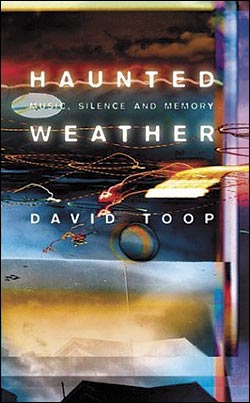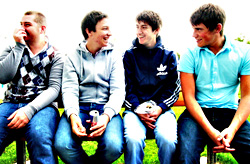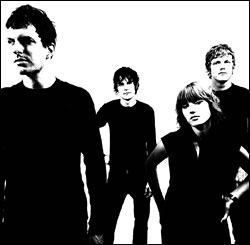Music takes a convoluted path to the heart, even in the simplest situations. Let’s say you’re at the pool on a cloudless evening, lounging inside an inflatable yellow duck. Zamfir is only a few feet away, on a sea serpent, playing whatever it is that people who play panpipes play on them. His plaintive lay starts as a dribble of electrical impulses in the cortex, surges down the spine to inform lips, lungs, and limbs, then floats to your ear as air molecules vibrating at various different frequencies.
By the time you feel anything about the music, Zamfir’s sound waves have gone through all kinds of complicated shit to meet their resonant end as electrical impulses in your brain—similar to his, but different. Throw in a drum kit, trumpet, or other primitive machine instrument, and the process gains a huge layer of mediation. A lot more can go wrong, too, from stuck valves to broken bass drum pedal straps. Windup Victrolas are even worse.
But those mishaps usually come with a quick fix—butter for the trumpet, a shoelace for the drum. Only when you start relying on outside-of-body electricity for making sound and listening to it are you truly planted atop a steaming mound of complexity and/or potential systems failure. Consider power outages, irreplaceable parts, tiny sparks from Zamfir’s soul transmuted to zeros and ones that the nimblest fingers can’t reach. Vinyl is a petroleum product. Shorted mikes can kill. A cracked motherboard embodies uselessness far better than a broken cymbal.
David Toop nails the conundrum impeccably in his newest book, Haunted Weather (Serpent’s Tail, $20). “As technology evolves,” the English writer, composer, curator, and musician observes early on, “you win some, you lose some.” Luckily, most of the accidents in Toop’s fourth book are happy ones. Composer Alvin Lucier stumbles upon the beautiful phantom feedback sounds that inform his Bird and Person Dying while trying to record an electronic Christmas ornament. On a lark, Danish field recordist Carl Weisman splices the unwanted barking on his tapes into an all-canine rendition of “Jingle Bells” that sells 500,000 copies in 1955—and more than a million 16 years later, after a radio DJ inadvertently sparks a massive revival. More serendipitously, Toop wanders far and wide from his ostensible topic—the effects of technology on us humanfolk—instead generating a richly detailed meditation on the whys and wherefores of what we hear and how we hear it.
The author’s MO comes as no surprise to the initiated; Haunted Weather’s fulsome patchwork of anecdote and observation is immediately recognizable to anyone familiar with the similarly structured Exotica and Ocean of Sound. An inveterate globe-trotter with an encyclopedic knowledge of topics, including but hardly limited to music, Toop fertilizes the vast expanses he covers with quotes from a panoply of culture workers, many acquired firsthand. “There was a sound in the air like nothing I’d ever heard before, a giant roaring noise in the air that I could not place or identify,” explains Lee Ranaldo in his account of 9/11’s sonic boot print as experienced from the roof of his downtown Manhattan home.
Nothing quite so traumatic appears on the book’s companion double-CD compilation on Staubgold, although tenderfeet are liable to be mightily daunted from the onset of opening track “Jukebox Capriccio.” Like most of the collection’s contents, Christian Marclay’s thrift-store vinyl-fueled, rapid-fire montage is mercifully short. This very brevity can also be the soul of frustration. Oval’s marvelously propulsive “8” hits the three-minute wall just as it leaves the ground. Drone-based works are even more grievously mauled by the truncation: Yurihito Watanabe’s “The Door Practice: Summer Solstice”—a spellbinding interlude informed by the advanced harmonic explorations of septuagenarian visionaries Pauline Oliveros and Roland Kayn, as well as the soundtracks much beloved by Toop—begins with a few snippets of dialogue (in Japanese) over sinister atmospherics, then swells into laminar layers of iridescent tonal color, just in time for goddamn disc one to terminate abruptly.
But the anthology has a valid excuse for its chronic auditus interruptus: In order to accurately reflect all the hallowed ground Toop covers in print, it would have had to be at least as long as the 10-disc History of Innovation in Music he co-compiled for Rykodisc toward the end of the last century, only to have the legume-tallying ghouls of Universal lumber onto the scene and grind the project into their $50-per-square-centimeter carpet. As it is, two poor finite discs can’t even begin to address the range of experimentica he discusses. And there’s a lot more to the book than the avant-garde domain that serves as his sound-making home. By way of a representative example, Toop endows the aforementioned Singing Dogs—right alongside like-minded ’50s and ’60s novelty hitmakers Spike Jones and Jack Fascinato—with their rightful places in a sampling canon that includes Pierre Henry, Grandmaster Flash, and Negativland.
Toop’s erudition, his facility at gliding from Marcel Duchamp to Kid Koala in a paragraph or two (while making the connections between the two more or less explicit), and the intricate web of friends and colleagues the artist has woven over the years, all help make Haunted Weather’s scant 260 pages as charming and compelling as they are. In 2004’s vacuous environs, where discourse about music gets more truncated all the time, David Toop’s big ears and bigger heart fly off the page like a blast of pure oxygen.








